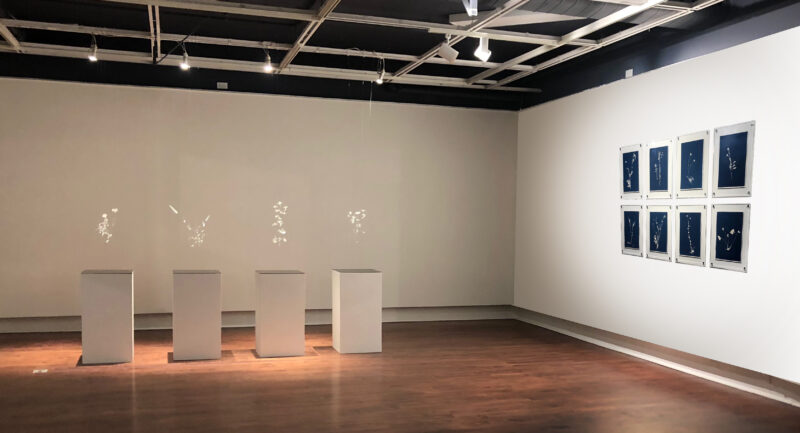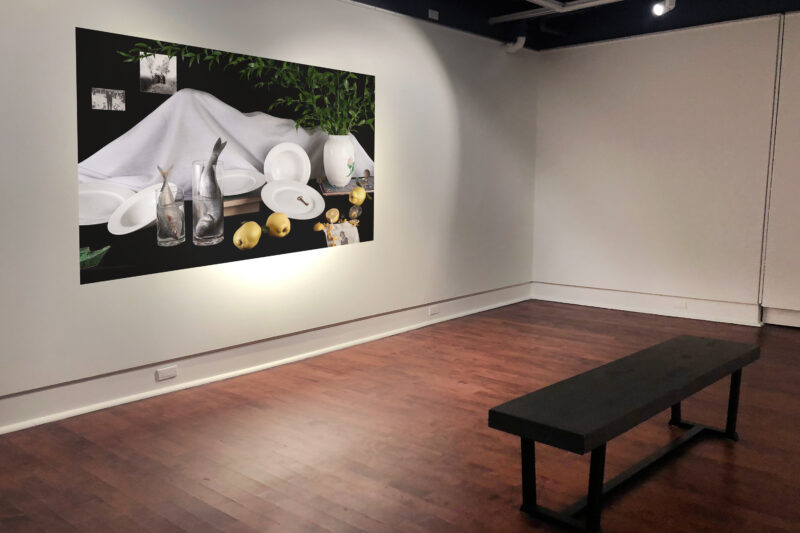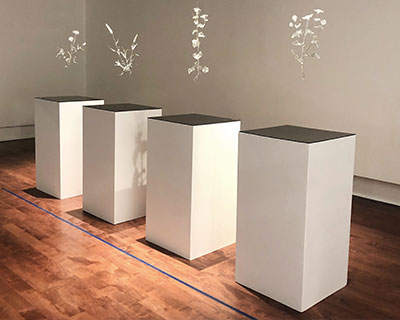An Interview with Anahita Norouzi
An Interview with Anahita Norouzi, artist of Other Landscapes at the Warren G. Flowers Art Gallery
By Sabrina Schmidt and Victoria Berthelet-Petrecca
Q: In Other Landscapes, you experiment with materials and find ways to reinvent established conventions. How did you come to discover these materials, and did this require any collaboration?
A: I always begin projects by doing research—once I have an idea I think about potential materials and what will best express the concept. I don’t possess all of the techniques or knowledge needed to work with all materials, so collaboration is important in my work, and though I may not be able to execute everything myself, I always take the opportunity to learn as much as I can about the materials and techniques I use in my projects.
Q: Your collaboration with eight refugees from the Middle East and Africa is an important part of the exhibition. How did you come about choosing and eventually working in a very personal and collaborative way with these individuals?
A: This aspect of the project took many months, filled with challenges and disappointments. The most difficult part was finding people who were willing to participate, without there being much in it for them, especially at first, when the ideas were still coming together. I tried going through official channels, but much paperwork was involved, and it made recruiting people more difficult. It was also important to me to have close to parity in terms of male and female participants in order focus on the human experience, above all. Eventually, through talking to people about my project and then posting on Facebook, I was able to connect with people who were willing to share their stories and most importantly, to trust me to convey these personal narratives to others.

Q: The objects in your Dutch Golden Age-inspired still life compositions stem from your conversations with participants abouts what things they had brought with them, or remind them of home. Yet the black background strips the objects of a definite position in time and space. Is this choice related to the theme of being displaced, not “belonging” to one country or one culture?
A: Using a black background was a strategy to decontextualize the objects; to create a sense of suspension or displacement. For these objects, the lack of context is the context. They are a lot like psychological portraits of each participant, they are my interpretations of them, their stories, and their objects. I was also thinking about [Carl] Jung and the “black void,” the concept of opening up space for the viewer to interpret the works themselves.
Q: Compared to the history of Dutch painting which you reference in Other Landscapes, women played a much more active role in the development of alternative methods of photography. Did this affect your choice to use cyanotypes prints?
A: I was aware of this, and though it is interesting and important, the reason I chose to work with photography and cyanotypes was because of the medium’s connection with colonial efforts to document “new” lands, resources, and people. In fact, I wanted to avoid any gender connotations in this exhibition, as I want the focus to be on the human aspect.

Q: Your knowledge and fascination with botany are unmistakable in this exhibition. Was the dual nature of botany as a scientific study and as a subject to explore through art something that you realized early on in your career?
A: The great thing about research and exploration is encountering new ideas. It was with this project that I became interested in botany. This is also why collaborating with other people is so important. At first, glass wasn’t part of the project, and neither were plants. These entered the work as a result of discussions with participants. In one case, a participant recounted walking in the woods here in Quebec, and how this and the plants she saw reminded her of her native country. This was followed by discussions about plants and weeds indigenous to the participants’ countries of origin, and so plants just seemed to be like the perfect fit for Other Landscapes.
Q: You describe plants brought into Canada as “invasive and foreign.” These are poignant words that commonly harbor negative connotations, and yet you chose these plants to be the subject of your glass work. As an immigrant yourself, does your description of these plants reflect the way you feel about how immigrants are perceived?
A: In short, yes. Weeds are super reproducers, designed to survive no matter what. Immigrants are trying to put roots down in a new place, to survive, to thrive. But the words “invasive” or “foreign” are just labels, and are part of the legacy of colonialism and the language used to talk about migration and immigration. One participant wondered: if a plant is categorized as invasive in Canada, but is native to North Africa, when Algeria was a colony of France, was the plant considered invasive then?
Speaking with Anahita we were struck by how committed she is to the research and conceptual development of her projects. As Visual Arts students, many of her answers encourage us to think critically about intention in our own practices. We are grateful to have had the opportunity to interview Anahita about Other Landscapes, as it has allowed us to see how much time, collaboration, and trust was involved in its conception.
The exhibition is open 11 a.m. to 7 p.m., Monday-Friday until Nov. 25, 2021.



